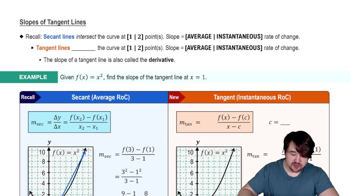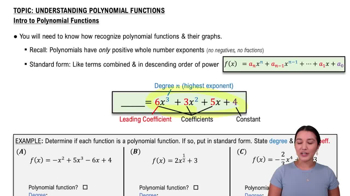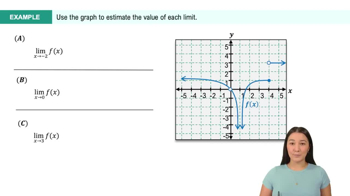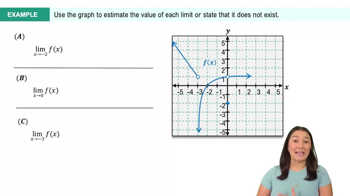Table of contents
- 0. Functions7h 52m
- Introduction to Functions16m
- Piecewise Functions10m
- Properties of Functions9m
- Common Functions1h 8m
- Transformations5m
- Combining Functions27m
- Exponent rules32m
- Exponential Functions28m
- Logarithmic Functions24m
- Properties of Logarithms34m
- Exponential & Logarithmic Equations35m
- Introduction to Trigonometric Functions38m
- Graphs of Trigonometric Functions44m
- Trigonometric Identities47m
- Inverse Trigonometric Functions48m
- 1. Limits and Continuity2h 2m
- 2. Intro to Derivatives1h 33m
- 3. Techniques of Differentiation3h 18m
- 4. Applications of Derivatives2h 38m
- 5. Graphical Applications of Derivatives6h 2m
- 6. Derivatives of Inverse, Exponential, & Logarithmic Functions2h 37m
- 7. Antiderivatives & Indefinite Integrals1h 26m
1. Limits and Continuity
Introduction to Limits
Problem 2.1.29a
Textbook Question
Tangent lines with zero slope
a. Graph the function f(x)=x^2−4x+3.
 Verified step by step guidance
Verified step by step guidance1
<Step 1: Understand the problem.> We need to graph the function \( f(x) = x^2 - 4x + 3 \) and identify where the tangent lines have a zero slope.
<Step 2: Find the derivative.> The derivative of \( f(x) \), denoted as \( f'(x) \), gives us the slope of the tangent line at any point \( x \). Calculate \( f'(x) \) using the power rule.
<Step 3: Set the derivative to zero.> To find where the tangent line has a zero slope, set \( f'(x) = 0 \) and solve for \( x \).
<Step 4: Solve for x.> Solve the equation from Step 3 to find the x-coordinate(s) where the slope of the tangent line is zero.
<Step 5: Graph the function.> Plot the function \( f(x) = x^2 - 4x + 3 \) and mark the point(s) found in Step 4 on the graph. These are the points where the tangent line is horizontal.>
Recommended similar problem, with video answer:
 Verified Solution
Verified SolutionThis video solution was recommended by our tutors as helpful for the problem above
Video duration:
6mPlay a video:
Was this helpful?
Key Concepts
Here are the essential concepts you must grasp in order to answer the question correctly.
Tangent Lines
A tangent line to a curve at a given point is a straight line that touches the curve at that point without crossing it. The slope of the tangent line represents the instantaneous rate of change of the function at that point. Understanding tangent lines is crucial for analyzing the behavior of functions, especially in relation to their derivatives.
Recommended video:

Slopes of Tangent Lines
Derivative
The derivative of a function at a point quantifies how the function's output changes as its input changes. It is defined as the limit of the average rate of change of the function as the interval approaches zero. For the function f(x) = x^2 - 4x + 3, finding the derivative will help identify points where the slope of the tangent line is zero, indicating potential local maxima or minima.
Recommended video:

Derivatives
Quadratic Functions
A quadratic function is a polynomial function of degree two, typically expressed in the form f(x) = ax^2 + bx + c. The graph of a quadratic function is a parabola, which can open upwards or downwards depending on the sign of the coefficient 'a'. Analyzing the graph of f(x) = x^2 - 4x + 3 will reveal its vertex, intercepts, and the nature of its tangent lines.
Recommended video:

Introduction to Polynomial Functions

 6:47m
6:47mWatch next
Master Finding Limits Numerically and Graphically with a bite sized video explanation from Callie
Start learning





